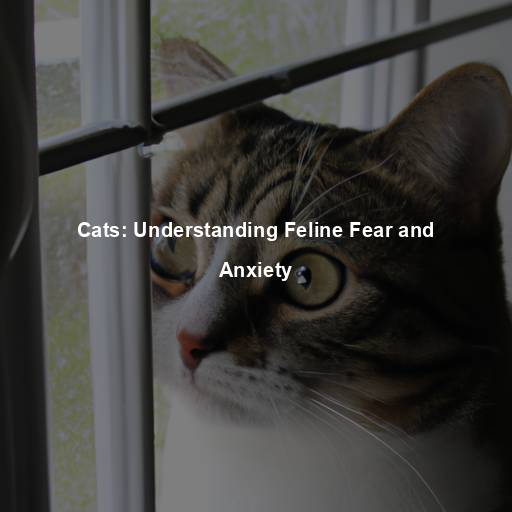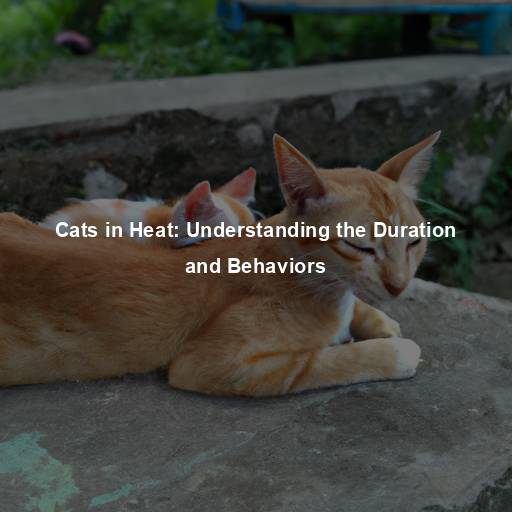Cats: Understanding Feline Fear and Anxiety
Last Updated on October 28, 2023 by Evan
Contents [hide]
- 1 Cats and Fear: A Complex Connection
- 1.1 Understanding Feline Fear
- 1.2 Signs of Feline Fear and Anxiety
- 1.3 Addressing Feline Fear and Anxiety
- 1.4 The Power of Empathy and Understanding
- 1.5 Fear of Loud Noises
- 1.6 Fear of New Environments
- 1.7 Fear of Loss of Control
- 1.8 Addressing Traumatic Experiences
- 1.9 Coping with Unfamiliar People or Animals
- 2 Seeking Professional Guidance
- 3 The Importance of Environmental Enrichment
- 4 The Power of Positive Reinforcement Training
- 5 The Role of Veterinary Consultation
- 6 FAQs for When Cats are Scared
- 6.1 What are the common signs that indicate a cat is scared?
- 6.2 What are some common reasons that can make a cat scared?
- 6.3 How should I approach a scared cat?
- 6.4 Should I try to console or pick up a scared cat?
- 6.5 How can I create a safe space for my scared cat?
- 6.6 When should I seek professional help for my scared cat?
- 6.7 Can scared cats be trained to overcome their fear?
Cats and Fear: A Complex Connection
Cats, with their mysterious nature and independent spirits, have long been associated with a certain air of aloofness. However, beneath their cool exterior lies a vulnerable side that is often overlooked – fear. Like any living being, cats experience fear and anxiety, but their unique instincts and behaviors make it challenging for us to fully comprehend and address these emotions. In this article, we delve into the world of feline fear, exploring the causes, signs, and potential solutions for easing anxiety in our beloved feline companions.
Understanding Feline Fear
It’s no secret that fear is deeply ingrained in our DNA, serving as a primal defense mechanism against potential harm. Cats, majestic creatures of both predator and prey, have inherited this innate response to danger. Their amped-up senses, honed through evolution, grant them a hyperawareness of their surroundings – the faintest sound, the subtlest movement, or the tiniest scent doesn’t escape their notice. But what happens when this heightened vigilance, designed for survival in the wild, collides with the comforts and confinement of our domestic abodes?
The Role of Early Socialization
The early days of a cat’s life hold the key to their future demeanor. Those little fluffballs who get to bask in the presence of various individuals, creatures, and surroundings during their critical formative phase – that golden period between 2 and 7 weeks – are bound to become self-assured and adaptable felines. Conversely, the ones deprived of such vital social encounters may find themselves plagued by unease and apprehension as they grow older.
Common Causes of Fear in Cats
When it comes to our feline friends, their acute sense of hearing can sometimes leave them feeling rather rattled. Startling sounds like booming fireworks, booming thunderstorms, or even the clamor of construction work can send their anxiety levels skyrocketing. These hair-raising experiences can leave our furry companions feeling perplexed and yearning for some tranquility. So, it’s important for us humans to be mindful of their delicate ears and create a serene environment whenever possible.
- Healthy Diet: A nutritious diet is essential for maintaining a cat’s overall well-being, but navigating the world of feline nutrition can be perplexing. With a plethora of pet food options available, it’s important to select a brand that meets their specific dietary needs. Bursting with protein and essential nutrients, a balanced diet not only keeps them healthy, but also supports their lustrous coats and sparkling eyes.
Exploring uncharted territories may leave our feline friends feeling rather unsettled and anxious. Cats, renowned for their attachment to routine, tend to find themselves in a state of vulnerability when faced with unfamiliar surroundings. This shift in environment often triggers a sense of unease and apprehension, leaving our four-legged companions bewildered and overwhelmed.
Cats, these enigmatic creatures, possess an innate desire for stability and mastery of their surroundings. Surprises and alterations that fall outside their jurisdiction tend to stir a bewildering mix of trepidation and unease within them. Maintaining a sense of peace and order in their lives is paramount to their well-being, as they navigate a world that often perplexes their feline sensibilities.
Witnessing or going through distressing situations can deeply impact our feline friends. Cats who have faced abuse or been involved in accidents may carry lasting emotional scars, leading to enduring fears and anxieties. Such traumatic experiences can shape their behavior and require specialized care to help them heal and feel safe again.
Cats can sometimes exhibit wariness towards unfamiliar people or animals, particularly if their previous encounters with unfamiliar individuals or animals have been less than positive.
Signs of Feline Fear and Anxiety
Understanding the fear and anxiety that can grip our feline friends is paramount, an enigmatic dance of signals that warrants unwavering attention. Caution overrides their nature, as some cats make a grandiose show of their unease, while others cloak themselves in subtle enigmas. Deciphering their cryptic communication lies in observing minute shifts in body language, a symphony of vocalizations, and changes in overall demeanor. Familiarize yourself with the clandestine markers of feline fear and anxiety, decoding their perplexing world one gesture at a time.
Physical Signs
Cat’s Eyes: Revealing a World of Emotions
Have you ever noticed how a cat’s eyes seem to change size? It’s not just a random occurrence – those dilated pupils actually hold a deeper meaning. As it turns out, when a feline feels fearful, their pupils naturally expand, and the advantages of this fascinating phenomenon go far beyond simple aesthetics. This biological reaction allows more light to enter their eyes, heightening their senses and enabling them to perceive the world in a whole new way.
2. Tense Body Posture: A fearful cat may have a hunched or crouched body posture, with their tail wrapped tightly around their body.
3. Erect Ears: Frightened cats often hold their ears erect and directed forward, enhancing their ability to detect potential threats.
One of the fascinating ways fear affects our feline companions is by giving their hearts a wild ride. Just like an adrenaline-fueled rollercoaster, fear can send their heart rates soaring, causing pulses to race at a remarkable pace. This sudden surge of palpitations is a surefire sign that fear has taken hold, leaving our furry friends with racing hearts and perplexed expressions.
When it comes to feeling scared or threatened, cats have their own unique way of handling it. They tend to disappear, finding refuge in secret hiding spots where they can regain their sense of security. These elusive creatures have a knack for vanishing into thin air, leaving us perplexed as to where they could possibly be hiding. Whether it’s under the bed or behind the curtains, cats seem to have mastered the art of disappearing when they need a moment of solace.
Behavioral Signs
Feline Anxiety: When it comes to anxiety, our furry companions can certainly throw us some curveballs. Take fearful cats, for example. In their attempt to cope, they might unleash their inner aggression, engaging in hissing, swatting, or even resorting to biting as a means of defense.
When it comes to our feline companions, we may occasionally come across a perplexing behavior known as excessive grooming. It turns out that some cats resort to this behavior as a means to self-soothe when they find themselves in an anxious state. The burst of grooming sessions may appear puzzling at first, but it is their unique way of finding comfort amidst their inner turmoil. So next time you catch your cat in a grooming frenzy, remember that it could be their way of coping with underlying anxiety.
Cats are masterful in creating an enigmatic dance of evasion, skillfully sidestepping those situations or stimuli that send shivers down their velvet-spun spines. With an uncanny ability to blend into the shadows of security, they seek out secret havens where a sense of safety and solace can be found. In a world bursting with uncertainty, cats navigate through the labyrinth of their fears with a perplexing grace that leaves us in awe of their elusive ways.
One of the most common challenges cat owners face is the perplexing behavior of their feline friends urinating or defecating outside the litter box. This burst of unexpected behavior can leave pet owners feeling bewildered and unsure of why their beloved cats are acting this way. Fear, often at the root of this tumultuous issue, can push cats to seek alternative elimination sites, leaving their owners scratching their heads for a solution.
It’s not uncommon for our feline friends to express themselves through vocalizations, but excessive meowing, yowling, or growling can be a sign of feline anxiety. Cats who find themselves overwhelmed or stressed may resort to these vocal expressions as a way to communicate their unease. If you notice your furry companion exhibiting an increased frequency of such vocalizations, it may be time to investigate what could be causing them distress and provide the necessary support and comfort. Understanding our cats’ unique ways of expressing themselves can help us decipher and alleviate their anxiety.
Addressing Feline Fear and Anxiety
When it comes to ensuring our beloved feline companions can navigate their daily lives with a sense of tranquility, it becomes essential to adopt a multifaceted approach. By synergistically blending adjustments to their surroundings, the implementation of uplifting reinforcement techniques, and, on occasion, expert guidance from veterinary professionals, we can forge an atmosphere that fosters peace and serenity for our furry friends. Below are a myriad of strategies to ponder and apply in order to empower our purring pals to conquer their fears and anxieties.
Creating Safe Spaces
Providing cats with designated safe spaces is essential for reducing fear and anxiety. These spaces should be quiet, comfortable, and easily accessible to the cat. Consider setting up cozy hiding spots, such as covered cat beds, cardboard boxes, or elevated perches, where your cat can retreat when they feel overwhelmed.
Gradual Desensitization
Helping your beloved feline friend overcome its fears and phobias is no small feat. But fear not! There’s a technique called gradual desensitization that can work wonders. By introducing your cat to its fear-inducing triggers in a controlled and gradual way, while also showering it with positive experiences and rewards, you can help your kitty build a more positive mindset and conquer its anxieties.
Positive Reinforcement Training
Using positive reinforcement techniques, such as clicker training, can help build your cat’s confidence and promote positive behaviors. By rewarding desired behaviors with treats, praise, or playtime, you can help redirect your cat’s focus away from fear-inducing stimuli and encourage more relaxed and confident responses.
Environmental Enrichment
Enriching your cat’s environment with interactive toys, scratching posts, and puzzle feeders can help alleviate boredom and provide mental stimulation. A stimulated and engaged cat is less likely to dwell on fearful thoughts and is more likely to feel secure and content.
Veterinary Consultation
In some cases, fear and anxiety in cats may require professional intervention. If your cat’s fear-related behaviors are severe, persistent, or significantly impact their quality of life, it’s essential to consult with a veterinarian or a feline behavior specialist. They can assess your cat’s specific needs and develop a tailored treatment plan, which may include behavior modification techniques or, in some cases, medication.
The Power of Empathy and Understanding
Caring for our enigmatic and captivating feline companions entails delicately traversing the intricate landscape of their fears and anxieties. Embracing the role of compassionate guardians, we must approach their emotional turmoils with unwavering empathy, unwavering patience, and an unwavering understanding. It is crucial to decipher the nuanced cues, cater to their idiosyncratic needs, and cultivate a harmonious haven that supports their journey through the labyrinth of apprehension. Remind yourself that each cat possesses a unique temperament, necessitating a personalized approach as a panacea for their unease.
Stay tuned for more insightful articles on PetsRoof.com, your go-to source for all things pets!## Recognizing and Addressing Specific Triggers
Fear of Loud Noises
Whether it’s the booming sound of fireworks or the rumble of thunder, our feline friends can easily become overwhelmed by loud noises, leaving them feeling fearful and anxious. To help create a sense of security during these perplexing moments, consider providing them with a peaceful oasis. Drawing the curtains and shutting windows can minimize both noise and flashes, while offering a cozy hideaway where they can find solace. Additionally, soothing white noise or mellow melodies can serve as a comforting buffer against the cacophony of commotion.
Fear of New Environments
Cats, those enigmatic creatures of habit, can be quite perplexed when confronted with the unfamiliar. The mere thought of venturing into uncharted territory can stir up a cocktail of fear and anxiety within them. So, when it comes to introducing your feline companion to a novel space, it’s essential to exercise patience and allow them to embark on their exploration at their own pace. Gradually expose them to different corners of the house, ensuring that familiar comforts such as their beloved bed or dear toys are within reach.
Fear of Loss of Control
Cats thrive on predictability and control over their environment. Any disruptions or changes beyond their control can evoke fear and anxiety. To help alleviate this, establish a consistent routine for feeding, playtime, and interaction. Providing them with choices, such as multiple litter box options or different scratching surfaces, can also give them a sense of control.
Addressing Traumatic Experiences
Cats, like humans, can carry the weight of past traumas, whether it be abuse or accidents that have left lasting emotional scars. As responsible caretakers, it becomes imperative to approach these delicate cases with nurturing compassion and unwavering patience. Seeking guidance from seasoned professionals such as veterinarians or behaviorists, who possess a wealth of experience in working with traumatized animals, can help formulate a customized roadmap that emphasizes trust-building exercises, positive reinforcement, and incremental exposure to once-frightening triggers. Let us embark on this journey of healing and transformation together, giving voice to these silent, yet resilient feline souls.
Coping with Unfamiliar People or Animals
There’s something about cats and strangers that doesn’t always quite click. Maybe they’ve had some hairy encounters before or simply prefer to keep their social circles tight-knit. When it comes to introducing your feline friend to new faces or furry friends, remember that patience is key. Let them take the lead and approach others at their own speed, while showering them with treats and kind words to foster good vibes.
Seeking Professional Guidance
Dealing with fearful felines can be quite the puzzle – one moment they may seem fine, and the next, their anxiety has skyrocketed. Although some situations can be tackled with simple adjustments and rewards, there may come a time when seeking professional help is unavoidable. Consulting a knowledgeable veterinarian or a certified feline behavior specialist can shed light on your cat’s perplexing behaviors, analyze their overall demeanor, exclude any lurking medical concerns, and offer invaluable advice on altering their conduct or even considering medication as a last resort.
Establishing a Strong Foundation
Early socialization plays a vital role in shaping a cat’s response to fear-inducing stimuli. During their critical developmental period, which typically occurs between 2 and 7 weeks of age, kittens are highly impressionable and more receptive to new experiences. Introducing them to a variety of people, animals, and environments during this time can help them build positive associations and develop resilience to potential fears later in life.
Positive Experiences and Exposure
Socializing kittens is an absolute necessity, and the key to success lies in crafting a tapestry of positive and secure encounters. Embracing a gentle handling approach, acquainting them with a cornucopia of sounds and tactile sensations, and facilitating supervised interactions with other cats and dogs who possess exemplary social skills – these are all elements crucial in shaping confident and adaptable feline companions. Furthermore, a gradual introduction to unfamiliar surroundings like car rides or veterinary visits is paramount in quelling the trepidation and unease often associated with such situations, forging a resilient and fearless spirit within our fur-clad friends.
Remedial Socialization for Fearful Cats
For cats that have missed out on proper socialization during their early developmental period, remedial socialization can still be beneficial. These techniques involve exposing fearful cats to positive and controlled experiences, gradually desensitizing them to previously fearful stimuli. Patience, consistency, and positive reinforcement are key when working with fearful cats, as it may take time for them to build trust and overcome their fears.
The Importance of Environmental Enrichment
Stimulating the Mind and Body
Creating an environment that sparks joy and curiosity is vital for our feline friends’ emotional and physical health. By introducing stimulating activities and mind-boggling challenges, we can whisk away their worries and whiskers alike. Don’t underestimate the transformative power of enriching their surroundings – it’s a key ingredient in their happiness recipe.
Interactive Toys and Playtime
Toys that encourage interactive play, such as wand toys or puzzle feeders, can help engage a cat’s natural instincts and provide mental stimulation. Regular play sessions not only provide physical exercise but also help build confidence and strengthen the bond between cats and their human companions. Experiment with different toys and play styles to find what your cat enjoys most.
Vertical Space and Hiding Spots
Cats yearn for a sense of security that comes with elevated territories, where their inelegant paws can gracefully ascend and claim a perch. By introducing towering cat trees, sophisticated shelves, or even marvelous window perches, we grant our feline friends an opportunity to survey their kingdom from a lofty sanctuary. Moreover, embracing the enigma of hiding spots adorned with sumptuous covered beds and snug blankets, we afford these curious creatures a secluded haven where they can unleash their inner controllers of their cryptic realm.
Scratching Posts and Other outlets
Cats, in their enigmatic ways, find solace in the act of scratching. It’s their instinctive way of stretching, asserting their presence, and keeping their claws primed and proper. To satiate their unpredictable desires, it’s crucial to scatter resilient scratching posts or boards strategically within your abode. And to cater to their ever-changing preferences, consider an assortment of textures – be it the rustic charm of sisal, the comforting embrace of carpet, or the rustic simplicity of cardboard.
The Power of Positive Reinforcement Training
Building Confidence and Trust
Positive reinforcement training is a valuable tool in helping cats overcome fear and anxiety. By rewarding desired behaviors with treats, praise, or playtime, we can help redirect their focus away from fear-inducing stimuli and encourage more relaxed and confident responses.
Counterconditioning and Desensitization
Counterconditioning and desensitization are techniques commonly used in behavior modification to help cats overcome specific fears or phobias. These techniques involve gradually exposing cats to the feared stimulus in a controlled and positive manner, while simultaneously providing rewards and positive associations. Over time, cats learn to associate the previously feared stimulus with positive experiences, helping to alleviate their anxiety.
Clicker Training and Targeting
Clicker training is a popular method that uses a clicker, a small device that makes a distinct sound, to mark desired behaviors. By pairing the clicker sound with a reward, cats quickly learn to associate the sound with positive reinforcement. Targeting, another training technique, involves teaching cats to touch a specific object, such as a target stick or hand, with their nose or paw. These techniques can help build a cat’s confidence, improve focus, and provide mental stimulation.
The Role of Veterinary Consultation
Identifying Underlying Medical Conditions
When it comes to our feline friends, understanding their fears and anxieties can be a real head-scratcher. Believe it or not, sometimes these furry bundles of joy may actually be experiencing underlying medical conditions that are causing their unease. Their subtle changes in behavior, like heightened fearfulness, could very well be a cry for help. So, don’t hesitate to fetch your cat and whisk them off to the vet for a comprehensive examination.
Behavior Modification Plans
If your cat’s fear-related behaviors persist or worsen despite your best efforts, seeking guidance from a veterinarian or certified feline behavior specialist is highly recommended. These professionals can assess your cat’s specific needs, develop a tailored behavior modification plan, and provide ongoing support and guidance throughout the process. They may suggest additional techniques, such as systematic desensitization or medication, to help address your cat’s fear and anxiety effectively.
FAQs for When Cats are Scared
What are the common signs that indicate a cat is scared?
When cats are scared, they exhibit various signs that can help you identify their fear. Common indicators include flattened ears, dilated pupils, a lowered body posture, fur standing on end (piloerection), a tucked tail, hissing or growling, hiding, and even aggressive behavior. Cats may also try to escape from the situation or crouch low on the ground.
What are some common reasons that can make a cat scared?
It’s truly remarkable how easily cats can be shaken by various stimuli. From the obvious culprits like booming noises and encountering unfamiliar environments or individuals, to more subtle disruptions like alterations in their daily routines or encounters with other furry friends, fear can take hold in felines. These delicate creatures are adorned with a sensitivity that surpasses our understanding, where even the slightest adjustments to their surroundings can cause their hearts to race with trepidation. The enigmatic nature of their past experiences, particularly traumatic ones, only adds to the perplexing equation of their fears.
How should I approach a scared cat?
When it comes to dealing with a timid feline, it’s all about playing it cool. Don’t rush the poor thing; instead, give them some breathing room and keep the chaos at bay. Project a serene aura with your gentle voice, coaxing them out of their shell. Let them call the shots and establish their comfort zone, and feel free to entice them with some delectable treats or engaging toys. If the scaredy-cat persists in their apprehension or unruly behavior, it’s advisable to consult the experts with their vet or an animal behaviorist to navigate this enigmatic road.
Should I try to console or pick up a scared cat?
Consoling and picking up a scared cat may not always be the best approach initially. While your instinct may be to comfort them physically, it’s important to let the cat feel in control of the situation. Forcing physical contact might escalate their fear or trigger defensive behavior, such as scratching or biting. Instead, create a calm and safe environment for the cat, provide hiding spots, and give them the option to approach you when they feel ready.
How can I create a safe space for my scared cat?
Helping a fearful feline feel secure is paramount, as peace of mind is invaluable to these timid creatures. Establishing a haven for your cat, be it a serene chamber or a cozy nook, is key. Fill it with plush bedding, secluded hideouts like cardboard crates or fancy condos, and familiar items imbued with your personal scent. Moreover, guaranteeing an impenetrable sanctuary featuring essential resources like sustenance, hydration, and a hygienic litter box, while warding off agitators like raucous clamor or fellow furry companions, will ensure a tranquil respite for your beloved feline friend.
When should I seek professional help for my scared cat?
If your furry feline friend seems to be perpetually gripped by fear, causing them to experience a decline in their overall well-being, or if their apprehension has taken a worrisome turn towards aggression, it may be time to connect with the experts. A trusted veterinarian or a seasoned animal behaviorist can carefully evaluate your cat’s unique circumstances, offering invaluable insights and personalized strategies to address their fearful demeanor. Moreover, these specialists possess the expertise to investigate and eliminate any underlying health concerns that may play a role in your cat’s distressing fear response. Embrace the opportunity to embark on a journey towards understanding and supporting your beloved companion.
Can scared cats be trained to overcome their fear?
It’s no secret that scaredy cats can conquer their fears with some well-placed effort. The secret lies in the art of desensitization and counter-conditioning. By gradually introducing the source of their fright in a safe and positive context, they can learn to associate it with pleasant experiences. However, this process requires finesse and careful handling to prevent overwhelming the furball and worsening the situation. It’s always wise to enlist the help of a pro to ensure success in your feline training endeavors.







